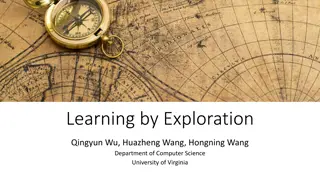Introduction to VTSS Exploration and Installation Series
"Join the VTSS Exploration and Installation Series to learn about roles, responsibilities, group norms, and how to establish a VTSS team effectively. Explore success criteria, Google Drive directions, and Division Exploration Team worksheets to kickstart your journey towards VTSS implementation."
Download Presentation

Please find below an Image/Link to download the presentation.
The content on the website is provided AS IS for your information and personal use only. It may not be sold, licensed, or shared on other websites without obtaining consent from the author.If you encounter any issues during the download, it is possible that the publisher has removed the file from their server.
You are allowed to download the files provided on this website for personal or commercial use, subject to the condition that they are used lawfully. All files are the property of their respective owners.
The content on the website is provided AS IS for your information and personal use only. It may not be sold, licensed, or shared on other websites without obtaining consent from the author.
E N D
Presentation Transcript
VTSS Exploration and Installation Series February 20, 2020
Welcome! Michael Gregory Virginia Tiered Systems of Support Specialist
Group Norms Be Responsible Make yourself comfortable Take care of your needs (water, food, restroom, etc.) Share your questions with the group Be Respectful Silence cell phones Listen to others attentively by staying quiet while they are speaking Complete assigned tasks and follow up as needed Be Engaged Ask what you need to know to understand and contribute Contribute to the team by sharing relevant information and ideas
Google Drive Directions Make sure you have the Google Drive link that was shared with your division. Inside the Google Drive folder and locate your division s folder. Please place all working documents in your folder to show your progress in the work. After each webinar we will review what documents need to be completed and placed within your folder. Remember this is a shared drive.
Establishing a VTSS Team Did you watch the recording on Establishing Your Team prior to this session? How did that go? Are the same people that watched this webinar with you today?
Division Exploration Team Worksheet
Lets get to know each other. Please share the roles that you have on our team and why you chose each person.
Success Criteria identify and document your exploration team members clearly define VTSS identify the roadmap for VTSS Implementation, our Implementation Matrix identify and review the VTSS Implementation Logic, our way of work identify the data you are hoping to change understand the importance of family and community partnerships begin developing your vision for the work, including how VTSS adds value to existing initiatives
Essential Questions As you learn about VTSS through E&I (Exploration & Installation), what information will help you explore the valued added to your current work, mission, and goals as a division? How will you engage with staff, families, and your community, with the goal of achieving equitable learning outcomes for all students? What information, data and collaborative dialogue is needed to inform the development of a comprehensive vision for the implementation of VTSS?
The What Virginia Tiered Systems of Supports (VTSS) integrates academics, behavior, and mental wellness into a framework for establishing the supports needed for a school to be an effective learning environment for all students. This systemic approach allows divisions, schools, and communities to provide multiple levels of support to students in a more effective and efficient, clearly defined process (VTSS, 2016).
Features of VTSS (adapted from McIntosh & Goodman)
VTSS = Systems Change Building this framework is a complex and iterative process. Students, staff, families, and community members are consistently included as planning partners. We cannot solve our problems with the same level of thinking that created them. Albert Einstein
Systems Change Involves Pause and discuss how you: Feel about change Respond to change What impacts how you think/feel about change?
Unfreezing (Changing) the System Kurt Lewin describes system change as unfreezing the existing system, changing it, and refreezing it in its new and more effective configuration (NIRN, 2016). Change (changing our way of work) isn t easy!
VTSS Implementation Logic OUTCOMES Supporting Staff Supporting Decision Making DATA SYSTEMS PRACTICES Supporting Students
The Three Tier Framework Tier 3 for a Few: Intensive, Individualized Tier 2 for Some: Targeted for Small Groups Tier I for All: Core/Universal
The Why How does this model align with/connect with current work in your division? What is the value added?
The How of VTSS We recognize the significant expertise, diverse experiences, strengths and investments that already exist in divisions which choose to participate. Practices that are effective in their impact on learning will be organized and aligned to be more efficient and effective. New practices are identified and implemented to meet needs that are identified by the divisions. A new framework evolves that is driven by the division s goals and local context.
VTSS Implementation Matrix 1.Aligned Organizational Structures Does this look familiar?
Implementation Components 1.Aligned Organizational Structure 2.Data Informed Decision Making 3.Evidence-Based Practices 4.Family, School, and Community Partnerships 5.Monitoring Student Progress 6.Evaluation
Implementation - Component 4 1.Aligned Organizational Structure 2.Data Informed Decision Making 3.Evidence-Based Practices 4.Family, School, and Community Partnerships 5.Monitoring Student Progress 6.Evaluation
A Central Component to our work! Sometimes educators assume that if families don t visit school or attend meetings, they must not care. Addressing this requires a shift in thinking from: How do we fix families? to: How do we fix the conditions that make engagement less accessible for families? All families have strengths and the capacity to positively contribute to the educational success of their child. Adapted from Devon Minch, PhD., (VTSS Family Event, March, 2019)
A family representative on your Division Exploration Team
Implementation - Component 2 1. Aligned Organizational Structure 2. Data Informed Decision Making 3. Evidence-Based Practices 4. Family, School, and Community Partnerships 5. Monitoring Student Progress 6. Evaluation
Supporting Improvements in Behavior, Academics, and Social-Emotional Wellness OUTCOMES Supporting Staff Supporting Decision Making DATA SYSTEMS PRACTICES Supporting Students
Data Infrastructure and Data Systems Data informed decision- making systems support adults in the effective and efficient implementation of instructional practices for teaching academic, behavior and mental wellness skills.
What DATA informs your need to implement VTSS? What are you hoping to gain from this experience? What needs to change? What are your goals? http://schoolquality.virginia.gov/
Why focus on data? Data allows us to understand need, identify areas for improvement, and develop meaningful action plans!
Organizing for Implementation What does your division use for data: PowerSchool SOL s MAPs Benchmarks Homegrown Evaluate current data systems for ease of use and functionality for aligned data driven decision making.
How are we organized to utilize data? Data Infrastructure Data Systems How is data collected and stored? How is data communicated?
Data Systems for Successful Implementation
For Example DATA SYSTEMS FOR SUCCESSFUL IMPLEMENTATION
Your Data Story Identify and analyze current baseline data to determine needs and prevalence of needs.
Familiar Data within Your Division Examples of School Data ODRs ISS OSS Attendance School climate Student surveys Universal screening Benchmark data SOLs Formative assessments Examples of Division Data Graduation rates Suspensions Attendance SOLs Referrals to Special Education % of students reading on grade level % of students accessing advanced classes % of students passing Algebra WIDA growth % going to 4 year or community college
Would you like to know more about... 1. The percentage of students by race who are experiencing out of school suspension? 2. Time of day, location and/or grade level for your ODR s? 3. ODR s and suspensions for your Special Education population? 4. What are the data points that your division consistently reviews across all schools? 5. What about the performance of English Learners on formative assessments?
Data Driven Decision Making Data that Indicates a Need What data answers questions you have about student outcomes related to academics and/or behavior? What data speaks to a division priority? What data speaks to outcomes that you would like to change? Please list the data points below.
Data Driven Decision Making 2 What is the story your data is telling about your students? Be precise! Describe who, what, when, where and why! The more precise the story, the more efficient and effective we can be in our decision-making! Again please tell the story through the lens of your division data.
Be Precise! Tell the data story! Try to explain who, what, when, where, and possibly the whys. Precision allows us greater efficacy and efficiency in decision making. Is there any data missing that you might need to go back and find in order to tell the story more completely? What does the data indicate about the climate of your school(s)? How does the behavior data impact academic data? Are you noticing any trends?
Data Driven Decision Making 3 Data that Indicates a Need What data answers questions you have about student outcomes related to academics and/or behavior? What data speaks to a division priority? What data speaks to outcomes that you would like to change? Please list the data points below.
Data Driven Decision Making 4 What is the story your data is telling about your students? Be precise! Describe who, what, when, where and why! The more precise the story, the more efficient and effective we can be in our decision-making! Again please tell the story through the lens of your division data.
Would you like to rewrite the end of your story?
Would you like to rewrite the end of your story? 2
Implementation - Component 3 1.Aligned Organizational Structure 2.Data Informed Decision Making 3.Evidence-Based Practices 4.Family, School, and Community Partnerships 5.Monitoring Student Progress 6.Evaluation
Supporting Improvements in Behavior, Academics, and Social-Emotional Wellness 2 OUTCOMES Supporting Staff Supporting Decision Making DATA SYSTEMS PRACTICES Supporting Students































